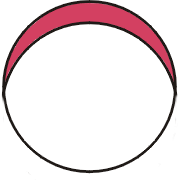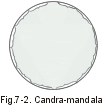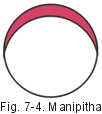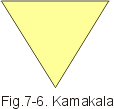
Candra Mandala
Awake
Vairocana

Supreme Bindu
Union
the Power of
Consciousness
Mind + Life or Prana
Samani
Satcitananda
Amoghasiddhi

Manipitha/Amakala
Radiation
Light
Para-Vak
"Seeing"
Feeling
Manipitha
Amakala
Nirvana-Shakti
Amitabha

Mahanada
Vibration
Intention
Pashyanti
Mirroring
Emptiness/Form
Parabindu
Sabdabrahman
Aksobhya

Kamakala Triangle
Archetypes
Triad
Network/energy
Madhyana
Equality
Equinimity
Jnana
Kriya
Brahma + Maya
Ratnasambhava

AKaTha Triangle
Manifestation
Vaikhari
Primary process
Purusa - Consciousness
Prakrti - Matter
Avalokitesvara
Aim Bija
 This is my rendition of the Sahasrara Padma apart from the usual head
with a thousand petals. I have constructed it from the detailed description
of its contents in Woodroffe’s (1973) book, The Serpent Power. The
multicolored petals around the circumference represent the thousand petals
of the other model. Although the descriptions of the inner parts were fairly
detailed, it was a challenging task because it felt like the model should
be three-dimensional, and I could not do that properly in such a
diagram. So what I am going to do is to take each symbol separately
and offer you a chart that shows how they should be read in sequence.
There are two charts. The one in this unit refers to the creative
process. So, reading from the top down, you are looking at the differentiation
process. I am including a few key words to help you later when you
refer to it. Notice that there is an inner set of 12 petals that belongs
to the Soma chakra though I have included it in the Candra-mandala.
The Soma chakra is actually not depicted but you can find a picture of it
in your Johari (1987) book. The Kameshvara chakra which is also in
the Sahasrara padma can be seen in the Johari book. These chakras
were not focal points in the Woodroffe book which I was using as my pattern
guide so are not included here.
This is my rendition of the Sahasrara Padma apart from the usual head
with a thousand petals. I have constructed it from the detailed description
of its contents in Woodroffe’s (1973) book, The Serpent Power. The
multicolored petals around the circumference represent the thousand petals
of the other model. Although the descriptions of the inner parts were fairly
detailed, it was a challenging task because it felt like the model should
be three-dimensional, and I could not do that properly in such a
diagram. So what I am going to do is to take each symbol separately
and offer you a chart that shows how they should be read in sequence.
There are two charts. The one in this unit refers to the creative
process. So, reading from the top down, you are looking at the differentiation
process. I am including a few key words to help you later when you
refer to it. Notice that there is an inner set of 12 petals that belongs
to the Soma chakra though I have included it in the Candra-mandala.
The Soma chakra is actually not depicted but you can find a picture of it
in your Johari (1987) book. The Kameshvara chakra which is also in
the Sahasrara padma can be seen in the Johari book. These chakras
were not focal points in the Woodroffe book which I was using as my pattern
guide so are not included here.




